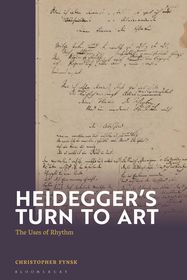
Heidegger's Turn To Art
The Uses of Rhythm
-
10% KEDVEZMÉNY?
- A kedvezmény csak az 'Értesítés a kedvenc témákról' hírlevelünk címzettjeinek rendeléseire érvényes.
- Kiadói listaár GBP 85.00
-
40 608 Ft (38 675 Ft + 5% áfa)
Az ár azért becsült, mert a rendelés pillanatában nem lehet pontosan tudni, hogy a beérkezéskor milyen lesz a forint árfolyama az adott termék eredeti devizájához képest. Ha a forint romlana, kissé többet, ha javulna, kissé kevesebbet kell majd fizetnie.
- Kedvezmény(ek) 10% (cc. 4 061 Ft off)
- Kedvezményes ár 36 548 Ft (34 808 Ft + 5% áfa)
Iratkozzon fel most és részesüljön kedvezőbb árainkból!
Feliratkozom
40 608 Ft

Beszerezhetőség
Megrendelésre a kiadó utánnyomja a könyvet. Rendelhető, de a szokásosnál kicsit lassabban érkezik meg.
Why don't you give exact delivery time?
A beszerzés időigényét az eddigi tapasztalatokra alapozva adjuk meg. Azért becsült, mert a terméket külföldről hozzuk be, így a kiadó kiszolgálásának pillanatnyi gyorsaságától is függ. A megadottnál gyorsabb és lassabb szállítás is elképzelhető, de mindent megteszünk, hogy Ön a lehető leghamarabb jusson hozzá a termékhez.
A termék adatai:
- Kiadó Bloomsbury Academic
- Megjelenés dátuma 2025. január 23.
- Kötetek száma Hardback
- ISBN 9781350410039
- Kötéstípus Keménykötés
- Terjedelem256 oldal
- Méret 238x164x18 mm
- Súly 476 g
- Nyelv angol 631
Kategóriák
Hosszú leírás:
In this major new contribution to Heidegger studies, Christopher Fynsk provides an original account of Heidegger's reflections on art, and in particular the poetic work of art, to explore the central yet overlooked Heideggerian idea that all art has a rhythmic character.
Following the development of Heidegger's thoughts on rhythm, this book focuses especially on the critical moment of Heidegger's turn to art in the mid-1930s and his reading of Friedrich Hölderlin's river hymns. This not only allows for a new reading of his monumental essay "The Origin of the Work of Art", but also a sustained analysis of his engagement with Hölderlin and Aristotle. Importantly, it further reveals the centrality of rhythm to Heidegger's thought and its relation to his other ideas. Indeed Fynsk connects rhythm to Heidegger's theorization of usage, "der Brauch", and in turn the role of usage to his reflections on the relation between being and human being.
Drawing on a wide range of art, from cave paintings to Francis Bacon, this is a significant and insightful study of the ontology of rhythm in Heidegger and beyond.
Tartalomjegyzék:
Introduction: The Rhythms of Usage
Chapter One: Rhythmic Transport
Chapter Two: The Rhythmic Figure
Chapter Three: Usage and Relation
Chapter Four: The Uses of Craft
Appendix: Aristotle's Poetics, Hölderlin's Remarks
In the Guise of a Conclusion




